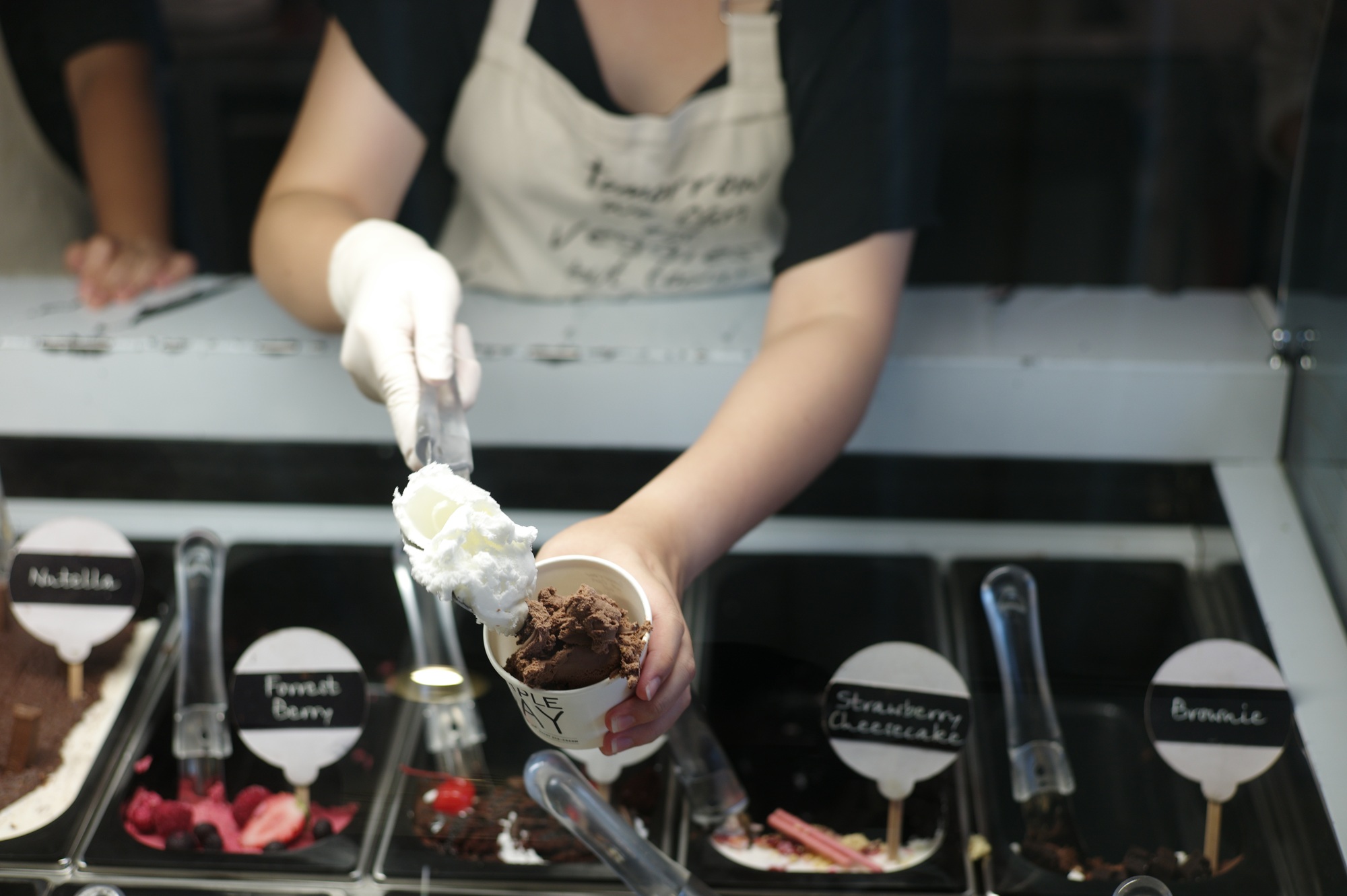Key Takeaways

- Market Research is Essential: Conduct thorough market research to understand local competition, customer preferences, and seasonal trends, which will significantly influence your ice cream shop’s success.
- Develop a Solid Business Plan: Create a comprehensive business plan outlining your shop’s concept, target market, expense projections, and marketing strategies to guide your operations effectively.
- Choose the Right Location: Select a high-traffic area that is accessible and visible to maximize customer visits and sales potential.
- Ensure Compliance with Legal Requirements: Understand and obtain necessary permits and licenses while adhering to local health regulations to operate legally and safely.
- Design an Inviting Shop Layout: Plan an efficient and welcoming interior design that enhances the customer experience and facilitates smooth workflow for staff.
- Effective Marketing Strategies are Crucial: Utilize social media, community events, and targeted promotions to create buzz and attract customers to your ice cream shop.
Dreaming of starting your own ice cream shop? You’re not alone. With its irresistible charm and endless flavor possibilities, an ice cream business can be a sweet venture that brings joy to your community. Whether you’re a passionate ice cream lover or an aspiring entrepreneur, the idea of serving up delicious scoops can be both exciting and rewarding.
How to Start an Ice Cream Shop

Starting an ice cream shop involves several key steps. Follow this guide to navigate the process effectively.
- Conduct Market Research
Identify local competition and customer preferences. Analyze existing ice cream shops and note popular flavors and service styles.
- Develop a Business Plan
Create a detailed business plan. Outline your concept, target market, projected expenses, and revenue projections. Include marketing strategies.
- Choose a Location
Select a high-traffic area to attract customers. Consider proximity to schools, parks, and tourist attractions. Evaluate rental costs and visibility.
- Obtain Necessary Licenses and Permits
Research local health regulations and business licenses required for food establishments. Secure permits to operate legally.
- Design the Shop Layout
Plan the interior and exterior design. Ensure the layout is inviting. Incorporate efficient workspace for staff and comfortable seating for customers.
- Source Equipment and Supplies
Purchase essential equipment such as ice cream machines, freezers, and serving supplies. Find quality ingredients for diverse flavor options.
- Create a Flavor Menu
Develop a unique and appealing flavor menu. Include classic options and innovative creations to cater to various tastes.
- Implement Marketing Strategies
Utilize digital marketing and social media to promote your shop. Create engaging content to attract customers. Consider local events for additional exposure.
- Hire Staff
Recruit friendly and efficient staff. Provide training on customer service and product knowledge. Ensure they embody your shop’s values.
- Launch the Shop
Plan a grand opening event. Offer samples and promotions to encourage initial visits. Collect feedback to improve your offerings continuously.
By following these steps, you will establish a solid foundation for your small business.
Research Your Market

Conducting market research serves as the foundation for your small business. Understanding local demand, target audiences, and competitor dynamics influences your shop’s success.
Analyze Local Demand
Evaluate the demand for ice cream by monitoring seasonal trends and peak sales periods. Ice cream often enjoys higher sales during spring and summer. Track local weather patterns and events that could affect customer traffic. For example, an unseasonably warm spring could boost early sales while winter months may see a decline unless your shop stays open year-round in a warm climate.
Identify Your Target Audience
Identify your target audience through surveys and community engagement. Consider demographics like age, income, and lifestyle preferences. Families with children often prioritize affordability and variety, while young adults might seek innovative flavors and experiences. Tailoring your marketing efforts and product offerings to specific audience segments ensures effective engagement.
Study Competitors
Study competitors by analyzing their offerings, customer service, and marketing strategies. Visit nearby ice cream shops to assess their product selection and pricing. Online reviews can provide insights into what customers value and where competitors may fall short. Learning from this information can help differentiate your ice cream shop in the local market.
Create a Business Plan

Creating a comprehensive business plan stands as a fundamental step in starting an ice cream shop. This plan details your vision and strategy, guiding your small business toward success.
Define Your Concept
Define your concept by identifying the unique theme, style, or experience your ice cream shop will offer. Consider options such as an artisanal focus, local ingredients, or a specific cuisine influence. Establish a clear mission statement that communicates your shop’s values and purpose. For example, a shop specializing in organic ingredients appeals to health-conscious customers.
Outline Your Menu
Outline your menu by selecting a variety of flavors and products that attract diverse tastes. Include traditional flavors like vanilla and chocolate, alongside unique offerings such as lavender honey or matcha green tea. Specify size options and additional treats like sundaes or smoothies to diversify the menu. Ensure your menu reflects your concept, with clear pricing strategies and seasonal specials to maintain customer interest.
Create Financial Projections
Create financial projections that encompass initial startup costs and expected monthly expenses. Consider factors such as rent, utility bills, ingredients, equipment, supplies, and staff wages. Develop a cash flow forecast to estimate revenue from daily sales, projecting numbers based on market analysis and seasonal fluctuations. Clearly outlining these aspects supports sustainable financial health for your small business.
Legal Requirements

Starting an ice cream shop involves understanding and complying with various legal requirements. These steps ensure your small business operates within the law, providing a solid foundation for success.
Choose a Business Structure
Select a legal structure for your business. Common options include:
- Sole Proprietorship: This structure is simple and economical to set up. Owners assume personal liability for all business debts and obligations.
- Partnerships: In a partnership, multiple individuals share profits and losses. All partners remain jointly liable for business debts.
- Limited Liability Company (LLC): An LLC offers limited liability protection to owners. This structure provides management flexibility and pass-through taxation, although it might entail self-employment taxes depending on the state.
Obtain Necessary Permits and Licenses
Acquire the specific permits and licenses to legally operate your ice cream shop. Required documents vary by locality and state. Common types include:
- Business License: A general license allowing operations within your jurisdiction.
- Food Service License: This license certifies compliance with food safety regulations.
- Health Department Permit: A permit issued by your local health department ensuring adherence to sanitary practices.
Check your local government’s website for an exhaustive list based on your specific location.
Comply With Health Regulations
Adherence to health regulations is critical in running your small business. Follow these guidelines to ensure safety and compliance:
- Food Safety Standards: Implement protocols for food handling, preparation, and storage. Training staff on hygiene practices helps maintain product quality.
- Inspections: Schedule regular health inspections as required by local authorities. These inspections ensure consistent compliance with health codes.
- Record Keeping: Maintain accurate records of food safety measures. Documentation aids in compliance and protects your business during inspections.
You can efficiently navigate the legal landscape by understanding these requirements, ensuring your ice cream shop’s successful launch and operation.
Finding a Location

Finding a suitable location is vital for starting a successful ice cream shop. Several factors can influence the overall success of your small business.
Consider Foot Traffic
Consider foot traffic when selecting a site. Opt for locations where people gather on foot, such as local town squares, near grocery stores, or close to parks. High foot traffic increases the likelihood of impulse purchases and repeat visits, maximizing your shop’s exposure.
Evaluate Rental Costs
Evaluate rental costs thoroughly. Assess the cost per square foot in various neighborhoods, factoring in your budget for startup expenses. Aim for locations that offer a balance between affordability and potential customer traffic to ensure sustainable business operations.
Assess Local Amenities
Assess local amenities in the area. Evaluate nearby businesses, public transportation, and parking availability. Proximity to popular attractions can enhance the visibility of your ice cream shop and draw more customers. A well-rounded location benefits both your shop and the local community, fostering customer loyalty and growth.
Designing Your Shop

Designing your ice cream shop involves careful attention to layout, decor, and workflow. Each element contributes to the overall customer experience and operational efficiency.
Plan the Layout
Focus on creating a practical floor plan that optimizes space for your kitchen and waiting area. Design the kitchen floor plan with areas for inventory management, storage for ingredients and supplies, prep space for employees, and a dishwashing area. Identify appropriate spots for large ice cream machines and equipment to ensure a streamlined workflow. Ensure the waiting area floor plan provides enough space for customers to comfortably queue and socialize. Position the ordering counter to facilitate an efficient ordering process and include seating options that cater to families, such as benches or play areas for young kids.
Choose Decor and Branding
Select decor that reflects your ice cream shop’s concept while attracting customers. Use colors and designs that evoke feelings of nostalgia, fun, or freshness. Consider incorporating visual elements such as artwork, signage, and unique furniture to enhance the overall ambiance. Ensure branding consistency across all platforms, from physical elements in the shop to online presence, reinforcing your shop’s identity and attracting your target audience.
Implement Efficient Workflow
Establish an efficient workflow that minimizes customer wait times while maximizing staff productivity. Design the kitchen layout for smooth movement between prep, service, and cleaning areas. Train staff on use and maintenance of equipment to streamline processes. Encourage teamwork and communication among employees to foster a cooperative environment, which can improve service quality and customer satisfaction.
Sourcing Ingredients and Equipment

Sourcing high-quality ingredients and equipment forms the backbone of your ice cream shop. Understanding where and how to acquire these essentials ensures business success.
Find Suppliers for Ice Cream Bases
Identify reliable suppliers specializing in ice cream bases. Research local and national distributors by attending trade shows and industry events. Build a network within the community to gain insights on reputable vendors. Focus on suppliers offering a diverse range of high-quality bases and flavorings. Negotiate terms that favor you, including competitive pricing and convenient delivery schedules.
Invest in Necessary Equipment
Acquire essential equipment to effectively produce and serve your ice cream. Purchase ice cream machines, freezers, display cases, and mixing tools. Aim for reliable brands known for durability and performance. Calculate your production capacity to select equipment that meets your shop’s demand while minimizing downtime. Consider investing in point-of-sale systems to streamline transactions and manage inventory efficiently.
Establish Relationships with Vendors
Cultivate strong relationships with your suppliers. Regular communication promotes trust, ensuring timely delivery and better service. Consider meeting suppliers in person to discuss quality expectations and future needs. Establish a mutually beneficial partnership by maintaining transparency about your purchasing volumes and business plans. Strong connections lead to improved negotiation opportunities and access to exclusive products.
Marketing Your Ice Cream Shop

Effective marketing can significantly enhance the visibility and success of your ice cream shop. Here are critical strategies to implement.
Develop a Marketing Strategy
Creating a structured marketing strategy serves as a roadmap for promoting your small business. Establish specific goals such as achieving a 20% increase in foot traffic within the first six months or gaining 1,000 followers on social media platforms. Develop milestones to track progress, including launching promotional campaigns or hosting community events. Outline your unique selling points to differentiate your shop, such as offering vegan options or unique flavor combinations. Collaborating with local businesses can also expand your reach and attract new customers.
Utilize Social Media
Leveraging social media enhances your shop’s presence among potential customers. Focus on platforms popular with your target demographic, such as Instagram and TikTok. Post engaging content like behind-the-scenes videos, flavor spotlights, and customer testimonials. Schedule posts at optimal times to maximize engagement. Run targeted ads to reach specific age groups or local neighborhoods, promoting special offers or new flavors. Consider using hashtags relevant to your small business to enhance discoverability.
Host Grand Opening Events
Hosting a grand opening event attracts attention and generates excitement for your ice cream shop. Plan activities like free samples, live music, or face painting to create an engaging atmosphere. Advertise the event through local community boards and social media, targeting nearby residents to ensure high attendance. Offer limited-time promotions during the event to encourage immediate sales, such as discounts on the first purchase. Engaging the local community builds rapport and encourages repeat visits.
Hiring Staff

Efficient staffing is vital for the successful operation of your ice cream shop. Thoughtful planning regarding staff roles and training enhances customer satisfaction and business performance.
Determine Staffing Needs
Assessing your staffing needs involves evaluating shop size and type. For a brick-and-mortar shop, a team of 4 to 10 employees contributes to smooth operation, especially during peak times. Considerations include peak seasons, the busiest days of the week, and weekly shifts. For instance, plan for additional staff during summer months when demand peaks.
Create Job Descriptions
Crafting clear job descriptions helps attract qualified candidates. Specify roles such as cashier, ice cream maker, and cleaner, outlining primary responsibilities and necessary skills. Include expectations regarding customer service, teamwork, and adaptability. For example, a job description for an ice cream maker may highlight responsibilities in flavor preparation and adherence to health regulations.
Implement Training Programs
Training programs ensure staff readiness and enhance service quality. Orientation sessions should cover product knowledge, customer service protocols, and health guidelines. Training new employees on operating equipment, handling transactions, and maintaining cleanliness fosters a professional environment. Regular refresher courses can also reinforce skills and introduce new procedures.
Troubleshooting Common Issues

Addressing common issues proactively enhances your ice cream shop’s operations. Here are key strategies for handling specific challenges.
Handling Equipment Failures
Identify equipment failures quickly to minimize disruption. Regular maintenance ensures optimal performance of ice cream machines. Schedule routine checks of your equipment every 1–3 months to detect any potential issues early. Keep a set of essential spare parts, such as belts and gaskets, on hand to facilitate quick repairs. Train staff on basic troubleshooting steps to empower them to resolve minor problems promptly, ensuring minimal downtime during busy hours.
Addressing Customer Feedback
Monitor customer feedback to improve your offerings consistently. Implement a feedback system that encourages patrons to share their experiences through surveys or comment cards after their visit. Analyze feedback trends to identify areas requiring improvement, such as flavor variety or service speed. Respond to negative reviews promptly and publicly online, demonstrating your commitment to enhancing the customer experience. Use positive feedback to reinforce effective practices and motivate staff.
Managing Inventory Shortages
Anticipate inventory shortages by establishing robust monitoring processes. Conduct weekly inventory checks to track ingredient levels and assess usage trends. Lessen the impact of unexpected shortages by maintaining strong relationships with suppliers, ensuring prompt restocking during peak demand periods. Create a buffer inventory for high-selling flavors such as chocolate and vanilla, allowing flexibility in supply. Implement an inventory management system to automate restocking alerts and streamline the ordering process for your small business.
Conclusion

Starting your own ice cream shop can be a rewarding journey filled with creativity and community connection. By following the steps outlined in this article you can build a solid foundation for your business.
With careful planning and a focus on quality ingredients and customer experience you’ll be well on your way to creating a beloved local spot. Embrace the challenges and celebrate the successes as you bring your unique flavors to life.
Your passion for ice cream can turn into a thriving business that delights customers and brings joy to your community. Now’s the time to scoop up your dreams and make them a reality.
Frequently Asked Questions

What are the key steps to start an ice cream shop?
Starting an ice cream shop involves conducting market research, creating a detailed business plan, picking a high-traffic location, and obtaining necessary licenses. It’s essential to understand local competition and customer preferences to outline a unique flavor menu and effective marketing strategies.
Why is market research important for an ice cream shop?
Market research helps identify local demand, seasonal trends, and target audiences. It also assists in analyzing competitors, enabling you to differentiate your shop and effectively position your offerings for success.
How can I ensure my ice cream shop’s financial health?
A comprehensive business plan that includes startup costs, monthly expenses, and cash flow forecasts is crucial. This financial roadmap helps in managing finances effectively and ensuring sustainability as the business grows.
What legal requirements should I be aware of?
You need to choose a business structure (sole proprietorship, partnership, or LLC) and obtain necessary licenses, such as a business license and food service permit. Compliance with health regulations and standards is essential for safe operations.
How should I choose a location for my ice cream shop?
Select a location with high foot traffic, like near parks or town squares, to maximize impulse purchases. Evaluate rental costs for affordability and assess local amenities, which can enhance visibility and customer loyalty.
What design aspects should I consider for my ice cream shop?
Focus on a practical layout that optimizes space for both kitchen and customer areas. Use decor that reflects your shop’s theme, ensuring branding consistency and creating an inviting ambiance for customers.
Where can I find high-quality ingredients and equipment?
Identify reliable suppliers within your community for ice cream bases and negotiate favorable terms. Invest in essential equipment like ice cream machines and POS systems to ensure efficient operations and high-quality offerings.
How should I market my ice cream shop?
Develop a structured marketing strategy with specific goals. Utilize social media platforms like Instagram and TikTok for engagement, and consider hosting grand opening events to create excitement and attract customers.
What staffing considerations are important for my shop?
Assess staffing needs based on shop size and peak demand. Create clear job descriptions to attract qualified candidates, and implement training programs to ensure high-quality service and staff readiness.
How can I handle common operational issues in my shop?
To troubleshoot equipment failures, conduct regular maintenance and train staff on basic troubleshooting techniques. Monitor customer feedback and manage inventory shortages with robust tracking and strong supplier relationships.
Image Via Envato: hwilson8, Image-Source, ibenkonig, Polinalebed, przemekklos, Lobachad, ethomander, wikornr, avanti_photo, luismanuelm, alvarogonzalez, shannonfieldsphoto, crieneimages



